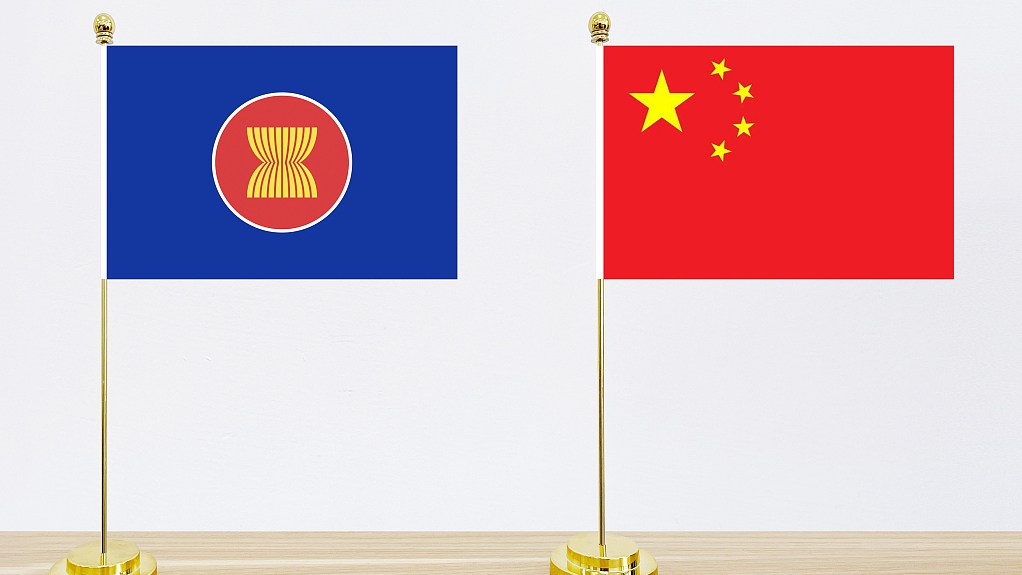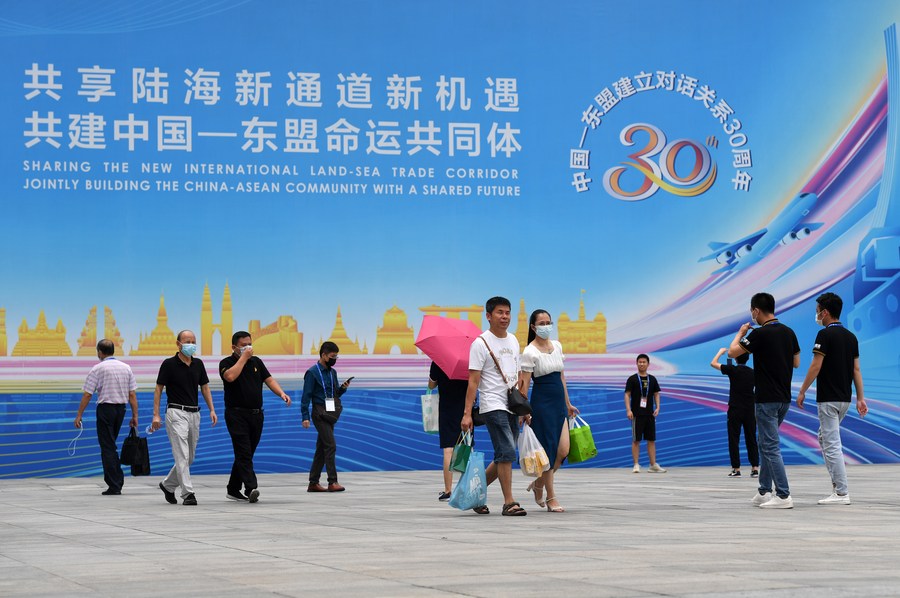
Flags of the ASEAN and China. /VCG
Flags of the ASEAN and China. /VCG
Editor's note: Professor Dai Yonghong is director of the Institute of Bay of Bengal Studies at Shenzhen University. The article reflects the author's views and not necessarily those of CGTN.
This year marks the 30th anniversary of ASEAN-China dialogue relations. China and ASEAN have grown from dialogue to mutual trust and from exchanges to cooperation. On Monday, Chinese President Xi Jinping chaired the ASEAN-China Special Summit to commemorate the anniversary in Beijing, and to celebrate the occasion and build a better future together.
Extensive consultation, joint contribution and shared benefits
Over the past three decades since the establishment of dialogue relations between China and ASEAN in 1991, China's exchanges with ASEAN countries have become increasingly close, and the average annual growth rate of bilateral trade is 16.5 percent.
In the first half of 2020, despite a decline in global trade due to the impact of COVID-19, trade between China and ASEAN increased, and they became each other's largest trading partner. This fully demonstrates the "increasingly sweet" trade relationship between China and ASEAN; in a true sense, the two sides are increasingly becoming a community with a shared future.
Since China put forward the Belt and Road Initiative (BRI) in 2013, ASEAN has been a priority and an important partner of the giant project for international cooperation. Cooperation between the two covers railways, roads, ports, airports, power and telecommunications.
Smooth progress has been made in major infrastructure projects such as the China-Laos Railway, the Jakarta-Bandung High-speed Railway in Indonesia, the New Land-Sea Trade Corridor jointly built by China and Singapore, and the "Two Countries, Two Parks" initiative between China and Malaysia.
Infrastructure connectivity has also shown significant spillover effects in trade, information and logistics. The LMC Special Fund has supported more than 500 projects in the fields of education, health, women's issues and poverty reduction, which has helped bring the benefits of development to the common people on the basis of promoting China-ASEAN economic integration.
China always supports ASEAN's exemplary role
The China-ASEAN strategic partnership has become one of the most substantive and dynamic partnerships in the Asia-Pacific region. As developing countries, China and ASEAN are major forces in safeguarding regional security and stability and driving regional economic prosperity.

A view of the 18th China-ASEAN Expo in Nanning, capital of south China's Guangxi Zhuang Autonomous Region, September 13, 2021. /Xinhua
A view of the 18th China-ASEAN Expo in Nanning, capital of south China's Guangxi Zhuang Autonomous Region, September 13, 2021. /Xinhua
In the face of rising protectionism and regional security threats, China firmly upholds multilateralism and the rules-based multilateral trading system, and supports ASEAN in playing an exemplary role in promoting security and development in the Asia-Pacific region.
ASEAN has independently put forward its own Indo-Pacific vision, stressing the principles of openness, transparency, inclusiveness, equality, mutual respect, mutual trust and mutual benefit, and the important principles of respect for sovereignty and non-interference in internal affairs. These concepts and principles are in line with the purposes of the UN Charter and China's foreign policy philosophy.
During the half a century of its development, ASEAN has gradually evolved from the edge of the Asia-Pacific security and development system to centrality, taking the initiative in assuming the historic task of the construction of the leading Asia-Pacific cooperation mechanism after the Cold War.
China stands ready to work together with ASEAN in its ongoing efforts for regional security and development and by taking significant responsibility in promoting regional cooperation.
Embarking on a new journey of bilateral cooperation
First, China and ASEAN will conduct strategic communication and dialogue with a more open attitude, strengthen cooperation in traditional and non-traditional security fields, speed up the consultation process on the Code of Conduct in the South China Sea (COC) and practical maritime cooperation, and build a maritime integration circle of peace and security.
Second, China will actively promote the facilitation of industrial cooperation with the goal of improving the livelihood of both sides by building complementary industrial chains, promoting industrial structure adjustment, realizing regional industrial structure upgrading, and enhancing the productivity and competitiveness of China and ASEAN in the international market.
Finally, both sides should deepen bilateral cooperation in science, technology and innovation, promote transformation in the digital era in advanced technologies such as 5G, artificial intelligence, big data and blockchain, and empower bilateral development with science and technology.
To sum up, China and ASEAN in the future will carry out more comprehensive and in-depth cooperation in maritime security, economic exchanges, sustainable development and other fields to achieve mutual benefit and common development.
(If you want to contribute and have specific expertise, please contact us at opinions@cgtn.com.)

